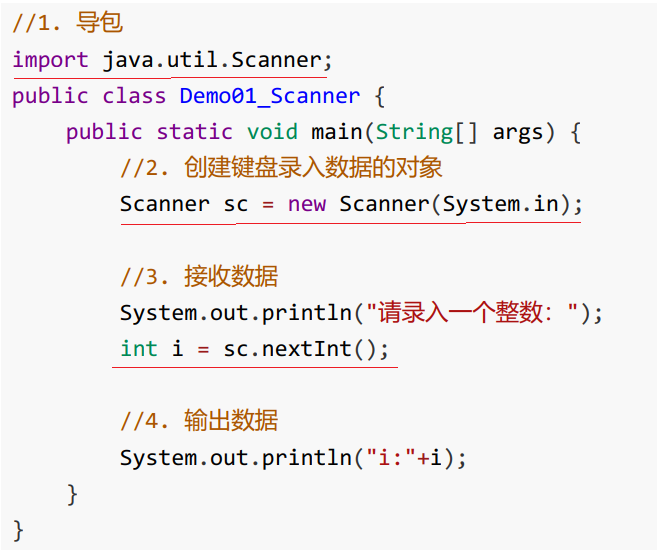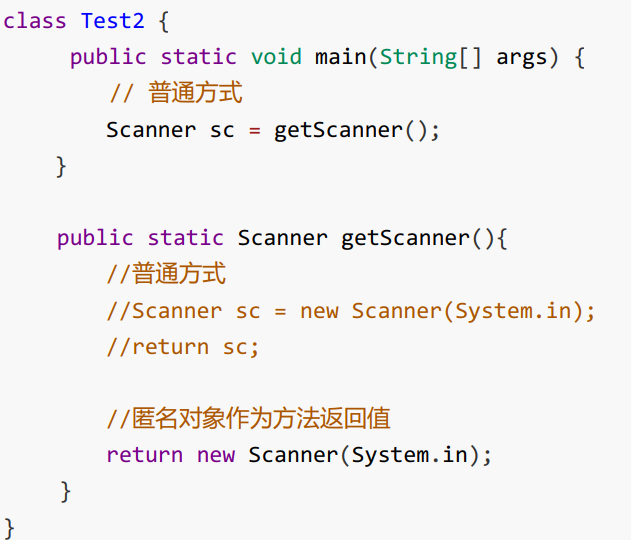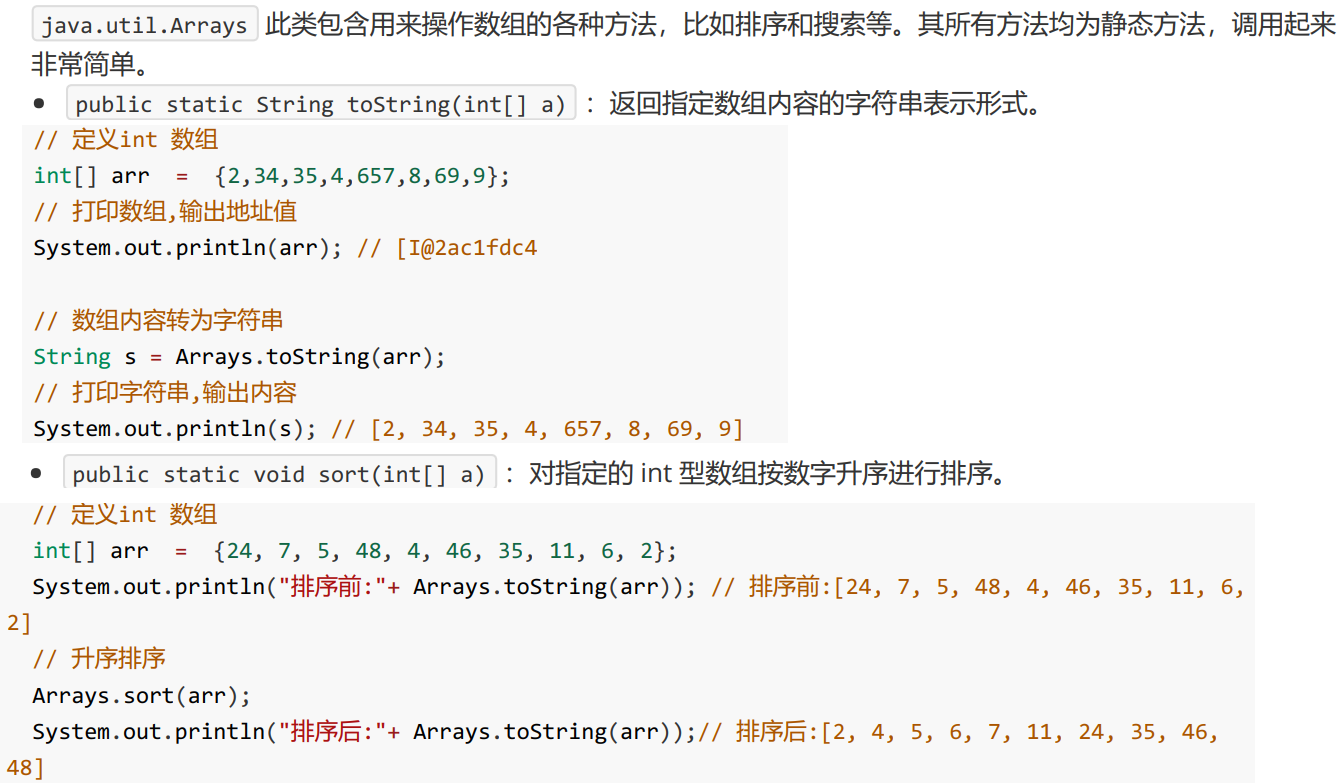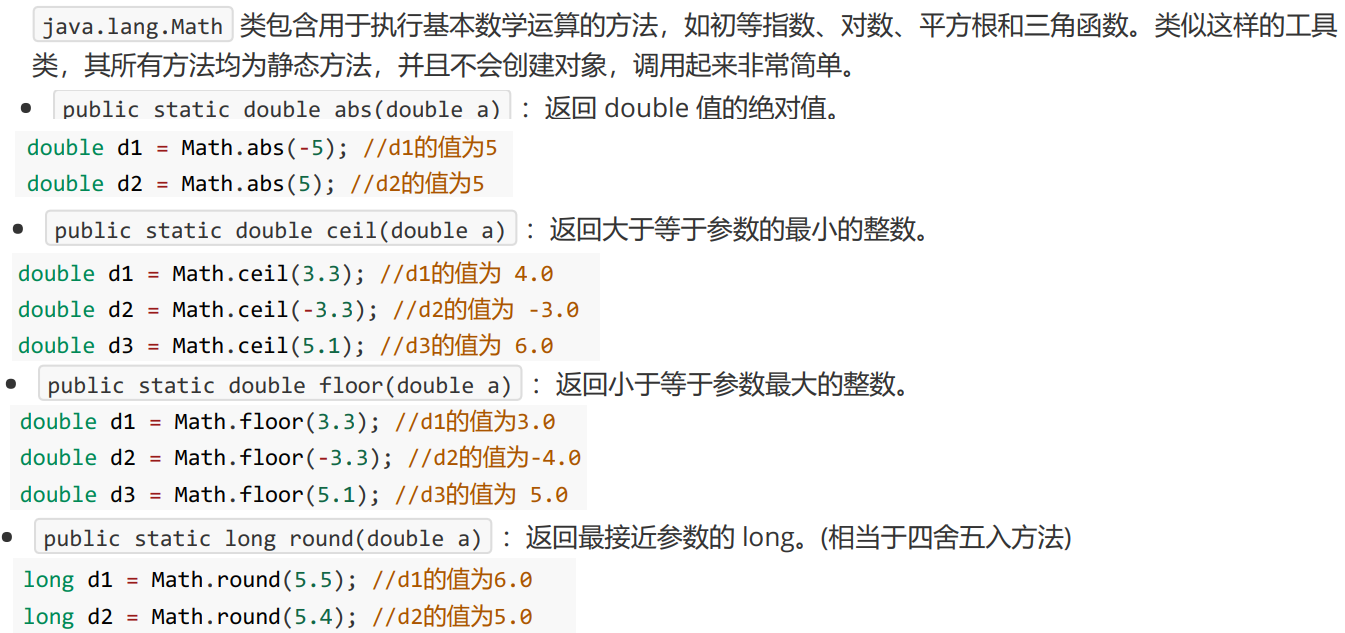Scanner类
一个可以解析基本类型和字符串的简单文本扫描器。
举例

匿名对象
创建对象时,只有创建对象的语句,却没有把对象地址值赋值给某个变量。虽然是创建对象的简化写法,但是应用场景非常有限。
匿名对象:没有对象名的对象。
格式: new 类名(参数列表);
举例:new Scanner(System.in);
应用场景:
1、创建匿名对象直接调用方法,没有变量名。
![]()
2、一旦调用两次方法,就是创建了两个对象,造成浪费。(一个匿名对象,只能使用一次)

3、匿名对象作为方法的参数和返回值
作为参数

作为返回值

Random类
类:java.util.Random 需要导入
构造方法:public Random() 创建一个新的随机数生成器
成员方法:public int nextInt(int n) 返回一个伪随机数,范围在0(包括)和指定值 n(不包括)之间的int 值。
举例:使用Random类,生成3个10以内的随机整数

String类
类:java.lang.String 此类不需要导入
String类构造方法
1、public String()
无参构造方法,用来创建空字符串的String对象。
1 String str1 = new String();
2、public String(String value)
用已知的字符串value创建一个String对象。
1 String str2 = new String("asdf"); 2 String str3 = new String(str2);
3、public String(char[] value)
用字符数组value创建一个String对象。
1 char[] value = {'a','b','c','d'}; 2 String str4 = new String(value);//相当于String str4 = new String("abcd");
4、public String(char chars[], int startIndex, int numChars)
用字符数组chars的startIndex开始的numChars个字符创建一个String对象。
1 char[] value = {'a','b','c','d'}; 2 String str5 = new String(value, 1, 2);//相当于String str5 = new String("bc");
5、public String(byte[] values)
用比特数组values创建一个String对象。
1 byte[] strb = new byte[]{65,66}; 2 String str6 = new String(strb);//相当于String str6 = new String("AB");
String类常用方法
1、求字符串长度
public int length()//返回该字符串的长度
1 String str = new String("asdfzxc"); 2 int strlength = str.length();//strlength = 7
2、求字符串某一位置字符
public char charAt(int index)//返回字符串中指定位置的字符;注意字符串中第一个字符索引是0,最后一个是length()-1。
1 String str = new String("asdfzxc"); 2 char ch = str.charAt(4);//ch = z
3、提取子串
用String类的substring方法可以提取字符串中的子串,该方法有两种常用参数:
1)public String substring(int beginIndex)//该方法从beginIndex位置起,从当前字符串中取出剩余的字符作为一个新的字符串返回。
2)public String substring(int beginIndex, int endIndex)//该方法从beginIndex位置起,从当前字符串中取出到endIndex-1位置的字符作为一个新的字符串返回。
1 String str1 = new String("asdfzxc"); 2 String str2 = str1.substring(2);//str2 = "dfzxc" 3 String str3 = str1.substring(2,5);//str3 = "dfz"
4、字符串比较
1)public int compareTo(String anotherString)//该方法是对字符串内容按字典顺序进行大小比较,通过返回的整数值指明当前字符串与参数字符串的大小关系。若当前对象比参数大则返回正整数,反之返回负整数,相等返回0。
2)public int compareToIgnore(String anotherString)//与compareTo方法相似,但忽略大小写。
3)public boolean equals(Object anotherObject)//比较当前字符串和参数字符串,在两个字符串相等的时候返回true,否则返回false。
4)public boolean equalsIgnoreCase(String anotherString)//与equals方法相似,但忽略大小写。
1 String str1 = new String("abc"); 2 String str2 = new String("ABC"); 3 int a = str1.compareTo(str2);//a>0 4 int b = str1.compareToIgnoreCase(str2);//b=0 5 boolean c = str1.equals(str2);//c=false 6 boolean d = str1.equalsIgnoreCase(str2);//d=true
5、字符串连接
public String concat(String str)//将参数中的字符串str连接到当前字符串的后面,效果等价于"+"。
1 String str = "aa".concat("bb").concat("cc"); 2 相当于String str = "aa"+"bb"+"cc";
6、字符串中单个字符查找
1)public int indexOf(int ch/String str)//用于查找当前字符串中字符或子串,返回字符或子串在当前字符串中从左边起首次出现的位置,若没有出现则返回-1。
2)public int indexOf(int ch/String str, int fromIndex)//改方法与第一种类似,区别在于该方法从fromIndex位置向后查找。
3)public int lastIndexOf(int ch/String str)//该方法与第一种类似,区别在于该方法从字符串的末尾位置向前查找。
4)public int lastIndexOf(int ch/String str, int fromIndex)//该方法与第二种方法类似,区别于该方法从fromIndex位置向前查找。
1 String str = "I am a good student"; 2 int a = str.indexOf('a');//a = 2 3 int b = str.indexOf("good");//b = 7 4 int c = str.indexOf("w",2);//c = -1 5 int d = str.lastIndexOf("a");//d = 5 6 int e = str.lastIndexOf("a",3);//e = 2
7、字符串中字符的大小写转换
1)public String toLowerCase()//返回将当前字符串中所有字符转换成小写后的新串
2)public String toUpperCase()//返回将当前字符串中所有字符转换成大写后的新串
1 String str = new String("asDF"); 2 String str1 = str.toLowerCase();//str1 = "asdf" 3 String str2 = str.toUpperCase();//str2 = "ASDF"
8、字符串中字符的替换
1)public String replace(char oldChar, char newChar)//用字符newChar替换当前字符串中所有的oldChar字符,并返回一个新的字符串。
2)public String replaceFirst(String regex, String replacement)//该方法用字符replacement的内容替换当前字符串中遇到的第一个和字符串regex相匹配的子串,应将新的字符串返回。
3)public String replaceAll(String regex, String replacement)//该方法用字符replacement的内容替换当前字符串中遇到的所有和字符串regex相匹配的子串,应将新的字符串返回。
1 String str = "asdzxcasd"; 2 String str1 = str.replace('a','g');//str1 = "gsdzxcgsd" 3 String str2 = str.replace("asd","fgh");//str2 = "fghzxcfgh" 4 String str3 = str.replaceFirst("asd","fgh");//str3 = "fghzxcasd" 5 String str4 = str.replaceAll("asd","fgh");//str4 = "fghzxcfgh"
9、其他类方法
1)String trim()//截去字符串两端的空格,但对于中间的空格不处理。
1 String str = " a sd "; 2 String str1 = str.trim(); 3 int a = str.length();//a = 6 4 int b = str1.length();//b = 4
2)boolean statWith(String prefix)或boolean endWith(String suffix)//用来比较当前字符串的起始字符或子字符串prefix和终止字符或子字符串suffix是否和当前字符串相同,重载方法中同时还可以指定比较的开始位置offset。
1 String str = "asdfgh"; 2 boolean a = str.statWith("as");//a = true 3 boolean b = str.endWith("gh");//b = true
3)regionMatches(boolean b, int firstStart, String other, int otherStart, int length)//从当前字符串的firstStart位置开始比较,取长度为length的一个子字符串,other字符串从otherStart位置开始,指定另外一个长度为length的字符串,两字符串比较,当b为true时字符串不区分大小写。
4)contains(String str)//判断参数s是否被包含在字符串中,并返回一个布尔类型的值。
1 String str = "student"; 2 str.contains("stu");//true 3 str.contains("ok");//false
5)String[] split(String str)//将str作为分隔符进行字符串分解,分解后的字字符串在字符串数组中返回。
1 String str = "asd!qwe|zxc#"; 2 String[] str1 = str.split("!|#");//str1[0] = "asd";str1[1] = "qwe";str1[2] = "zxc";

Math类

